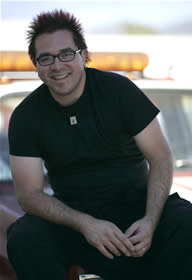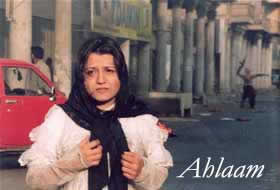 Bijan Tehrani: Please tell us about the history of the Santa Barbara International Film Festival and how you got involved with it?
Bijan Tehrani: Please tell us about the history of the Santa Barbara International Film Festival and how you got involved with it?
Roger Durling: The film festival has been around for 22 years. I took over four years ago when the festival was floundering and it was in dire straits financially. What we did was position the festival smack in the middle of Awards season. The festival now opens two days after the Academy award nominations are announced. Four years ago, we hosted Peter Jackson and Charlize THeron a month before they were to be crowned at the Oscars – and the prestige and notoriety of the festival has been growing ever since. Last year, we honored Philip Seymour Hoffman, George Clooney, and this year we have Helen Mirren, Forest Whitaker, Will Smith, Bill Condon and Al Gore among others.
Bijan: How has the public had been reacting to the festival? Do you get a lot of new visitors every year or are your attendees mostly return visitors? I personally think that majority of the film fans in US aren’t fond of film festivals. Has the magic and beauty of Santa Barbara changed this?
Roger: We do get a lot of visitors. About 50k. I feel Film Festival could be thought of elitist. Our approach is trying to change that. We feature the foreign films and demanding fare that you find in other festivals, but we mix it up with surf films, cult films and nature films. We like to mix low brow with high brow. It’s a pretty diverse festival in that regard. Festivals should be like a candy store – lot of choices for the film lover.
Bijan: At Cinema Without Borders we find the categories set for movies at the Santa Barbara International Film Festival are cleverly chosen. It makes it very  easy for everyone to find the movie they want to see. How did you come up with the categories and which category has been best received so far?
easy for everyone to find the movie they want to see. How did you come up with the categories and which category has been best received so far?
Roger: The categories reflect the Santa Barbara community at large. For example, 35% of our population is Latino – so 35% of the festival programming is Latino and Spanish films. There’s a big part of the community that surfs and does extreme sports, so we have a TO THE MAXX section that features surf, mountain biking and extreme sports films. This community is big on the environment and nature, so we have a nature films sections, and so on…Every sidebar/section of the festival is closely tied to Santa Barbara. The most popular sidebar is probably the TO THE MAXX section.
Bijan: Your personal favorite movies mentioned on your Blog ( 8 1/2, The Searchers, Unforgiven, Moulin Rouge, Eternal Sunshine of the Spotless Mind,) show your great taste; do you have a vote in the selection committee of the festival? And please tell us how the movies are selected for the festival?  Roger: I oversee the selection process. We receive over 3000 submissions and we have a screening committee. My head programmer and I also travel to several film festivals like Toronto, Telluride and AFI looking for films. Between the submissions and our research, we select the final program. That’s my favorite part of my job!
Roger: I oversee the selection process. We receive over 3000 submissions and we have a screening committee. My head programmer and I also travel to several film festivals like Toronto, Telluride and AFI looking for films. Between the submissions and our research, we select the final program. That’s my favorite part of my job!
Bijan: It is nice that as a festival director you are not afraid of mentioning your favorite movies at the festival: Dark Blue Almost Black and Beauty in Trouble. (Our readers should check http://sbiff.org/blog2/). Has anyone ever complained about this matter? (we find it very human, giving the festival a personal and artistic touch)
Roger: I tried to do it as little as possible because I will hurt some filmmaker. I shouldn’t do it, but I can’t help it at times. 🙂
Bijan: How important is the presence of the world cinema at Santa Barbara International Film Festival? Please name a few of the world cinema directors that are attending the festival?
Roger: It is vital because most of these films don’t get the exposure they should have. Local multiplexes don’t show these types of movies. We have numerous  world cinema directors attending ranging from Mohamed Al Daradji from Iraq with his film AHLAAM to Venezuelan director Jose Ramon Novoa with his film EL DON.
world cinema directors attending ranging from Mohamed Al Daradji from Iraq with his film AHLAAM to Venezuelan director Jose Ramon Novoa with his film EL DON.
Bijan: The Festival has a few events, such as the Sir David Attenborough Award for Excellence in Nature Filmmaking, that show the responsibility that the organizers want to address regarding the vital issues of our time. Has an award move like this ever been interpreted as a political move of any kind?
Roger: Our awards have never been interpreted as a political move. We started the David Attenborough Award three years ago to celebrate the best in nature filmmaking. AN INCONVENIENT TRUTH is the most prominent / important film of this genre this past year – and it was a no brainer we needed to salute Guggenheim and Gore for their achievement.
Bijan: The Santa Barbara International Film Festival has a very interesting way for holding the filmmakers retrospectives: allowing the film makers to pick the movies they like for this event. How did you come up with this idea and how successful has it has been?
Roger: The credit goes to Paul Fagen – the tribute director – he created this format and has been the mastermind behind all of our tributes for years. He’s very creative and wonderful to work with. He takes great pride in assembling these evenings.
Bijan: Please tell us about the future of the Santa Barbara International Film Festival.
Roger: I will not stop until we make it one of the best festivals in the US.

